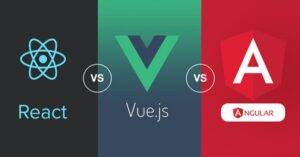Front-end development has witnessed remarkable evolution over the years, driven by the constant innovation in technology. As we step into 2024, the landscape of front-end frameworks continues to evolve, presenting developers with an array of options to choose from. In this comprehensive guide, we delve into the latest trends in front-end frameworks, aiding you in selecting the perfect technology stack for your next project.
Understanding the Importance of Front-end Frameworks
Front-end frameworks play a pivotal role in web development, offering developers a structured approach to building user interfaces. They provide a foundation of pre-written code, components, and libraries, streamlining the development process and enhancing efficiency. By leveraging the right front-end framework, developers can create responsive, interactive, and visually appealing web applications that cater to modern user expectations.
Exploring the Dominant Front-end Frameworks Trends in 2024
React.js: Powering Dynamic User Interfaces
React.js continues to dominate the front-end development landscape in 2024, owing to its robust ecosystem and unparalleled performance. Developed by Facebook, React.js enables developers to build dynamic user interfaces with ease, thanks to its component-based architecture and virtual DOM rendering. Its popularity is further bolstered by the extensive community support and a plethora of third-party libraries and tools.
Vue.js: The Rising Star of Front-end Development
Vue.js has emerged as a formidable contender in the realm of front-end frameworks, gaining traction among developers worldwide. Known for its simplicity and versatility, Vue.js offers a progressive framework that can be seamlessly integrated into existing projects. With its intuitive syntax and comprehensive documentation, Vue.js empowers developers to build sophisticated single-page applications with minimal overhead.
Angular: Embracing Enterprise-grade Solutions
Angular remains a prominent choice for enterprise-grade web development, renowned for its scalability and robust feature set. Developed and maintained by Google, Angular provides a comprehensive solution for building large-scale, mission-critical applications. Its extensive tooling, dependency injection, and built-in testing support make it a preferred choice for organizations seeking to deliver complex web solutions with confidence.
Comparing React.js, Vue.js, and Angular: Making an Informed Choice

When it comes to selecting the right front-end framework for your project, it’s essential to understand the key differences between React.js, Vue.js, and Angular. Each framework comes with its unique set of features, advantages, and considerations, catering to different development preferences and project requirements. Let’s explore a comparative analysis to assist you in making a well-informed decision:
Architecture and Data Binding
React.js:
- Utilizes a virtual DOM for efficient rendering, minimizing DOM manipulation overhead.
- Implements a unidirectional data flow, enabling predictable state management through props and state.
Vue.js:
- Employs a reactive and component-based architecture, facilitating seamless data binding and reusability.
- Offers both one-way and two-way data binding options, providing flexibility in managing component state and communication.
Angular:
- Adopts a comprehensive MVC (Model-View-Controller) architecture, with built-in support for bidirectional data binding.
- Employs TypeScript for static typing and enhanced tooling, promoting robustness and maintainability in large-scale applications.
Learning Curve and Developer Experience
React.js:
- Known for its minimalistic and lightweight approach, making it easy for developers to grasp and integrate into existing projects.
- Offers a rich ecosystem of third-party libraries and tools, enhancing productivity and developer experience.
Vue.js:
- Prized for its gentle learning curve and intuitive syntax, ideal for beginners and seasoned developers alike.
- Provides comprehensive documentation and a vibrant community, fostering collaboration and knowledge sharing.
Angular:
- Requires a significant learning curve due to its extensive feature set and intricate architecture.
- Offers extensive tooling and dependency injection, empowering developers to build scalable and maintainable applications once the learning curve is overcome.
Community Support and Ecosystem
React.js:
- Backed by Facebook and a vast community of developers, ensuring continuous innovation and support.
- Boasts a rich ecosystem of third-party libraries and tools, catering to diverse use cases and requirements.
Vue.js:
- Supported by a passionate community of developers and maintained by its creator, Evan You.
- Offers a growing ecosystem of plugins and extensions, expanding its capabilities and versatility.
Angular:
- Developed and maintained by Google, with robust community support and enterprise adoption.
- Provides a comprehensive ecosystem of Angular Material, CLI (Command Line Interface), and AngularFire, facilitating end-to-end development and deployment.
Performance and Optimization
React.js:
- Known for its exceptional performance and efficient rendering, thanks to the virtual DOM and reconciliation algorithm.
- Offers built-in optimization features such as code splitting and server-side rendering, enhancing speed and scalability.
Vue.js:
- Exhibits impressive performance metrics, with minimal overhead and fast rendering capabilities.
- Supports advanced optimization techniques such as tree shaking and component-based lazy loading, optimizing bundle size and load times.
Angular:
- Boasts powerful optimization capabilities, including Ahead-of-Time (AOT) compilation and tree shaking.
- Offers built-in support for Progressive Web Apps (PWAs) and service workers, ensuring fast and reliable performance across devices.
Choosing the Right Framework: Factors to Consider
When deciding between React.js, Vue.js, and Angular, consider the following factors to ensure compatibility with your project requirements:
Project Complexity: Assess the complexity of your project and choose a framework that aligns with its scalability and maintenance needs.
Developer Experience: Consider the skill set of your development team and select a framework that offers a comfortable learning curve and robust developer tools.
Community Support: Evaluate the strength of each framework’s community and the availability of resources, including documentation, tutorials, and third-party libraries.
Performance: Analyze the performance metrics of each framework and choose one that prioritizes efficient rendering and optimization.
Ecosystem and Tooling: Explore the ecosystem of each framework and the availability of supplementary tools and libraries for enhanced functionality.
Crafting Your Front-end Future: Navigating Trends for Success
Navigating the ever-changing landscape of front-end frameworks requires careful consideration and evaluation of various factors. Whether you opt for the flexibility of React.js, the simplicity of Vue.js, or the scalability of Angular, choosing the right technology stack is paramount to the success of your web development project. By staying abreast of the latest trends and best practices, you can harness the power of front-end frameworks to create exceptional web experiences that captivate and delight users.

